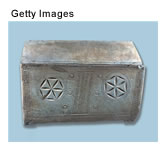When you take away the hype, the poor scholarship, and the overblown misinterpretations, all that remains of many recent biblical ‘discoveries’ is ‘more junk on Jesus,’ observes Dr. Paul L. Maier.
by Dr. Paul L. Maier
By now we’ve come to expect it: Once, twice a year or more, some “sensational” new archaeological or manuscript discovery in the Bible lands threatens to undermine Christianity, so it is claimed. Or it may be the radical opinion of some revisionist scholar that gets media attention, sending worried believers to their pastors. It all seems to be part of a trend that I call “More Junk on Jesus,” since so many of the “discoveries” don’t even apply or are misinterpreted, while most of the “new, scholarly insights” foisted on a credulous public are neither new nor scholarly. All of them have this in common: They are vastly overblown. Consider the most recent offenders.
The Judas Gospel
 This document arrived, courtesy of the National Geographic, just in time for Easter two years ago. Rather than succeeding in its effort to turn Judas into a hero, this Gnostic gospel was incorrectly translated, and the proffered text is an embarrassment to serious scholarship.
This document arrived, courtesy of the National Geographic, just in time for Easter two years ago. Rather than succeeding in its effort to turn Judas into a hero, this Gnostic gospel was incorrectly translated, and the proffered text is an embarrassment to serious scholarship.
The church is not “trying to hide” this piece of ancient literature: Feel free to Google “Judas Gospel” and print out all of its 12 pages—if you wish to waste paper—or just read it off your computer screen. You will be astonished that it is mere word-salad reflecting Gnosticism, that most ancient Christian heresy, and full of terms with Gnostic jargon, such as luminaries, aeons, demiurges, demons, firmaments, and secret knowledge.
All the Judas Gospel does is to affirm the reliability of that great defender of the faith, Irenaeus of Lyons, who, around A.D. 180, wrote Against Heresies. In this book, he complained about a pathetic sect that had named itself after the world’s first murderer—Cain—and called themselves the Cainites, who published a ridiculous work called the Judas Gospel.
The ‘Jesus Family Tomb’
 Last year, again just in time for Easter, the Discovery Channel gifted us with the story of a burial cavern accidentally uncovered at Talpiot in south Jerusalem. (Never mind that the find was made back in 1980, and that this was now the third attempt to turn it into a sensation.) Inside the cavern were 10 ossuaries (bone boxes), six of which are inscribed with names that include Jesus, Joseph, and Mary.
Last year, again just in time for Easter, the Discovery Channel gifted us with the story of a burial cavern accidentally uncovered at Talpiot in south Jerusalem. (Never mind that the find was made back in 1980, and that this was now the third attempt to turn it into a sensation.) Inside the cavern were 10 ossuaries (bone boxes), six of which are inscribed with names that include Jesus, Joseph, and Mary.
The TV program, hosted by an overenthusiastic-but-woefully-mistaken Canadian film producer, Simcha Jacobovici, claimed that another of the ossuaries with the name Mariamene e Mara referred to Mary Magdalene, thus “assuring” us with 600-to-1 odds that this was the family tomb of Jesus, which contained an ossuary with His bones.
Because names like Jesus or Mary were common, and for at least a dozen other reasons, this was impossible, but the clincher was this: Several weeks after the telecast, the Israeli archaeologists who were involved in the dig checked their records as to the bones in that particular ossuary. Inside were two sets of women’s bones; hence their original translation was correct: “Mariamme and Martha,” not “Mary Magdalene.”
Jesus Walks on Ice?
Then, of course, there was the logic-challenged climatographer from a Florida university who explained how Jesus could walk on water. He was treading on ice! Never mind that the Gospel account has Peter joining Jesus on this water-walk—for a while, at any rate, until he was frightened by the wind and the waves. An amazing body of water, the Sea of Galilee: Evidently the northern half was a sheet of ice, while the southern half must have had open waters!
And finally, the most recent rubbish on the Redeemer:
The ‘Gabriel Revelation’
An oblong, three-foot stone tablet, originally found on the east shore of the Dead Sea and presently owned by David Jeselsohn, an Israeli-Swiss collector, tells of a suffering Messiah who died and would rise in three days, so it is claimed. The stone was not found in the course of an archaeological dig, nor was it engraved; it contained lettering in ink, much ofit faded. Lettering styles placed the script in the first century B.C., according to specialists, thus before Jesus’ time. As a result, headlines in major publications screamed “Will a Stone Tablet Shake Christianity?” and “Stone Tablet Casts Doubt on the Resurrection.”
This, of course, is ridiculous for many reasons, but two in particular: First, the text itself is by no means clear or agreed upon by scholars. It is rather pock-marked by questionable renderings and many elisions (omissions) where no readings are possible, especially a crucial line 86. And yet Israel Knohl, professor at Hebrew University in Jerusalem, is bold to translate the critical passage regarding a suffering Messiah: “In three days you will rise. . . . I, Gabriel, command you.” One doubts that in the end this will be the official translation.
Second, even if this reading were accepted, what’s the point? Some commentators have suggested that this is where the idea of a suffering Messiah first arose in Judaism, which is absurd. The Old Testament has many passages regarding the Messiah who will suffer, e.g., Gen. 3:15, Psalm 22, and Isaiah 52 and 53. Nor is this where a resurrection concept first arose in Judaism. If that were the case, how could the Pharisees before Jesus’ day believe in a resurrection? Accordingly, the Gabriel stone actually supports rather than subverts the biblical record.
What is unconscionable is Professor Knohl’s conclusion that the Christian Gospels adapted the existing concept of a suffering Messiah who would rise in three days as a pattern for their own stories about Jesus. Since he had come to this mistaken conclusion long before the Gabriel stone appeared, his translation and response are highly suspect and not shared by other scholars in Israel. Other translations of the “Gabriel stone” will doubtless be attempted, none of which will pose any threat to Christianity.
All these vaunted “sensational” discoveries are discounted by serious scholars. Will they undermine Christianity? Only if someone with a peashooter can demolish the Rock of Gibraltar.






To the Gabriel stone, it is my belief that “so what” if it’s dated to 4 b.c. which it so happens to be. In that same year Jesus was proclaimed to his family in Nazareth by the angel Gabriel. To me it goes hand in hand, the story. What if in Bethlehem which is fairly close to the Qumran community, that a scribe got word of the proclamation and wrote what was said to Mary down… That’s just my opinion.